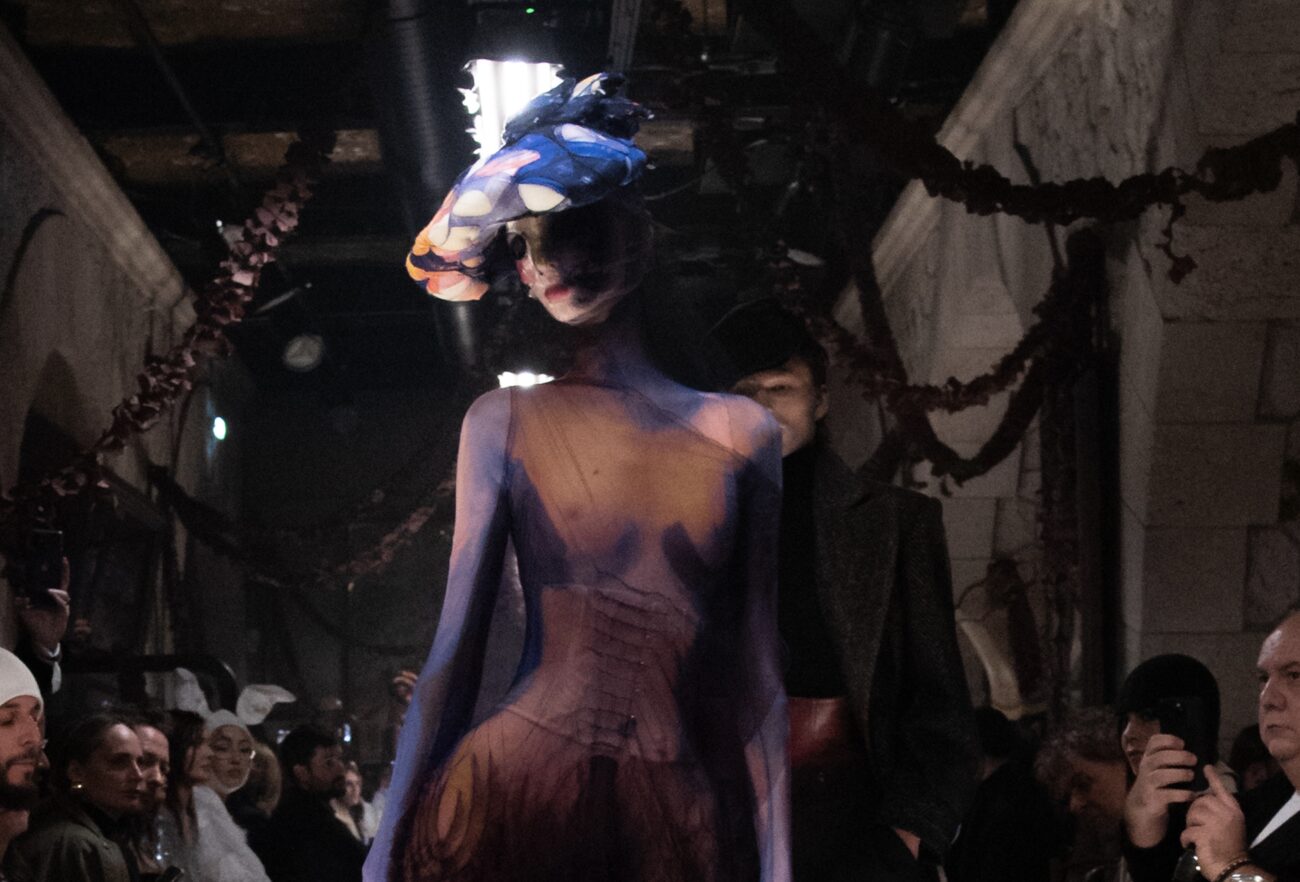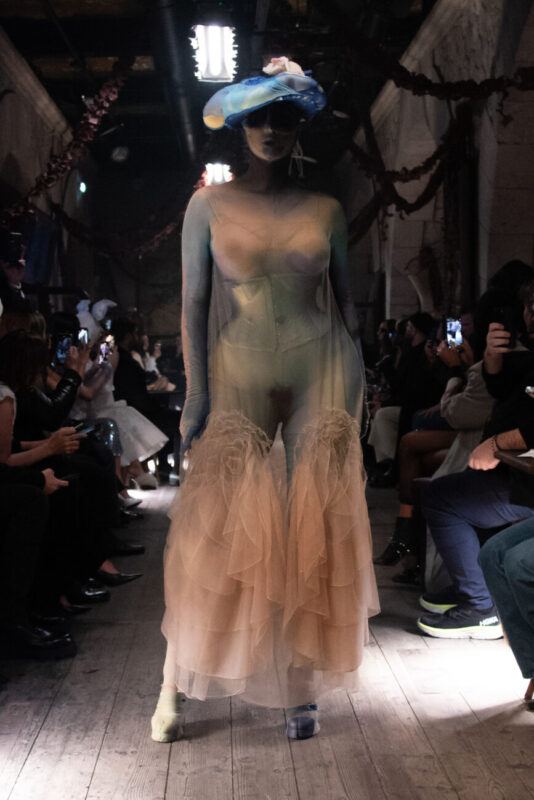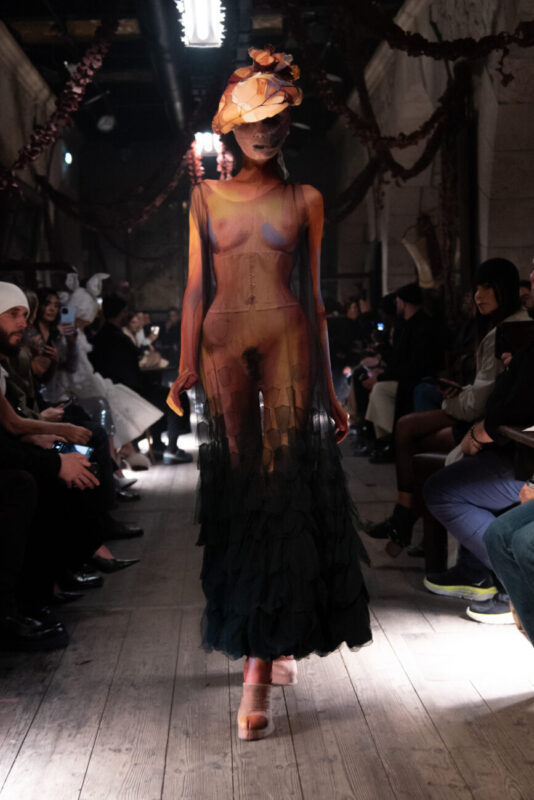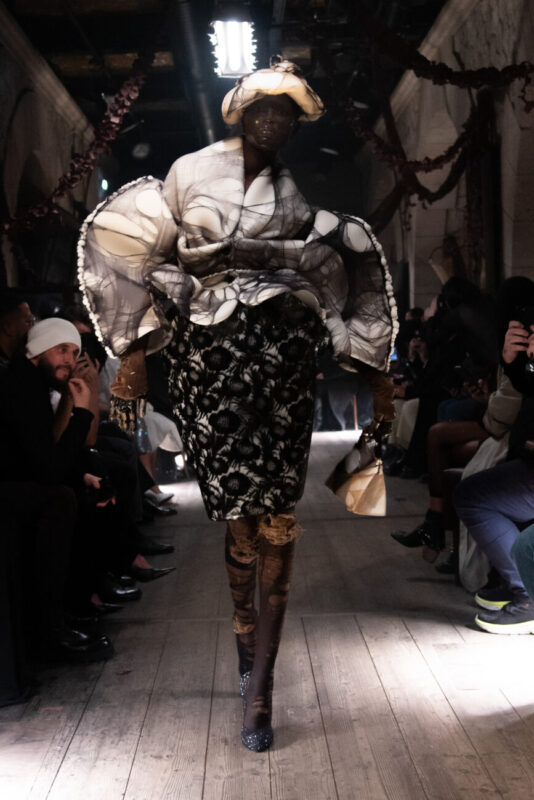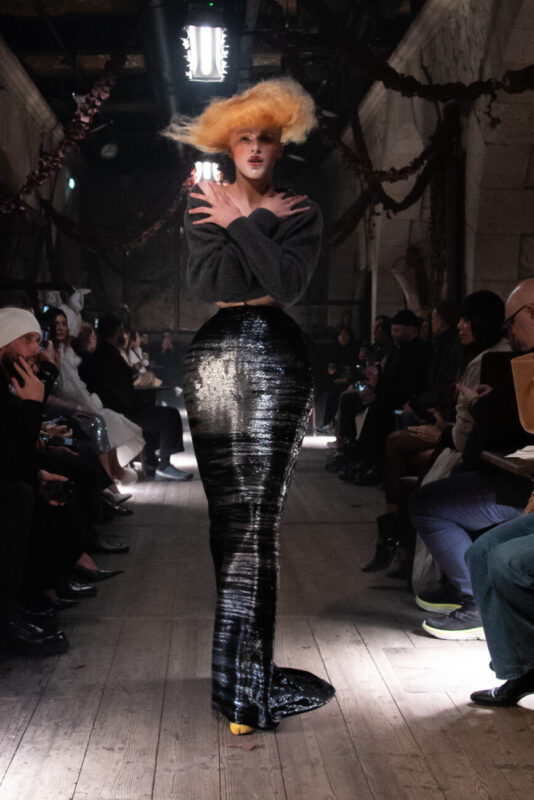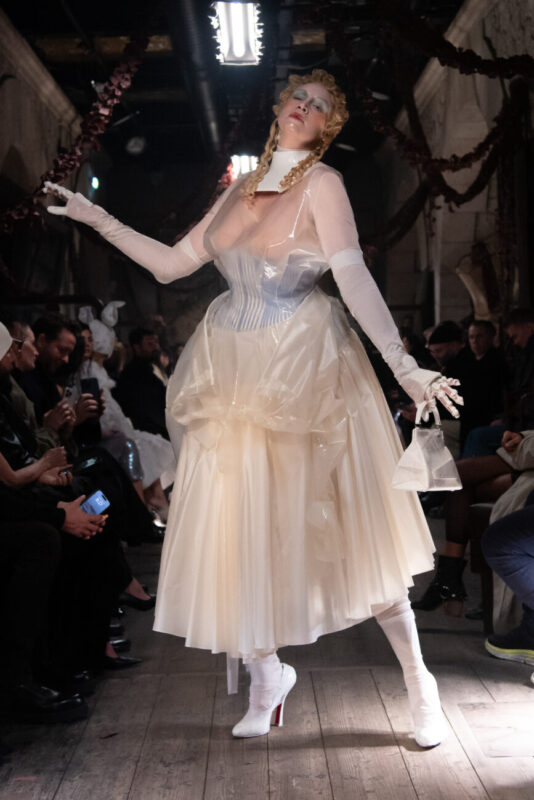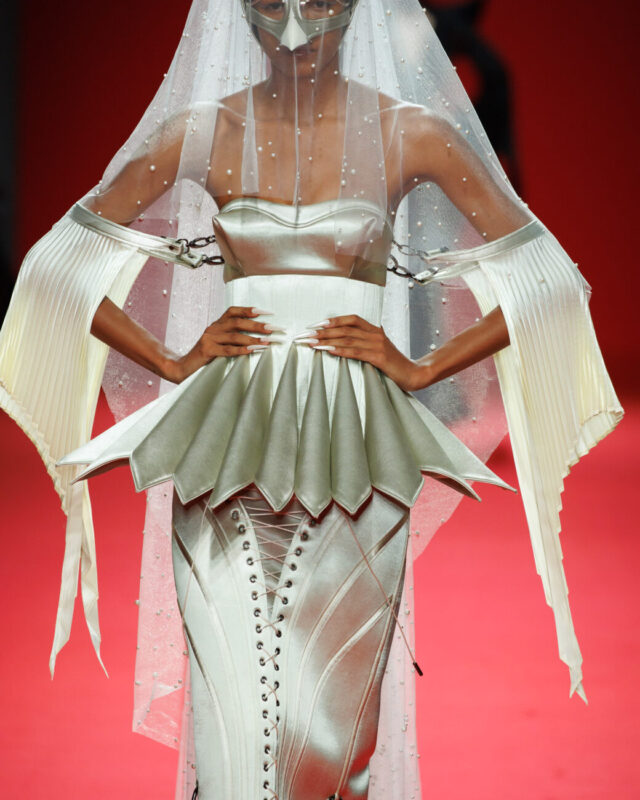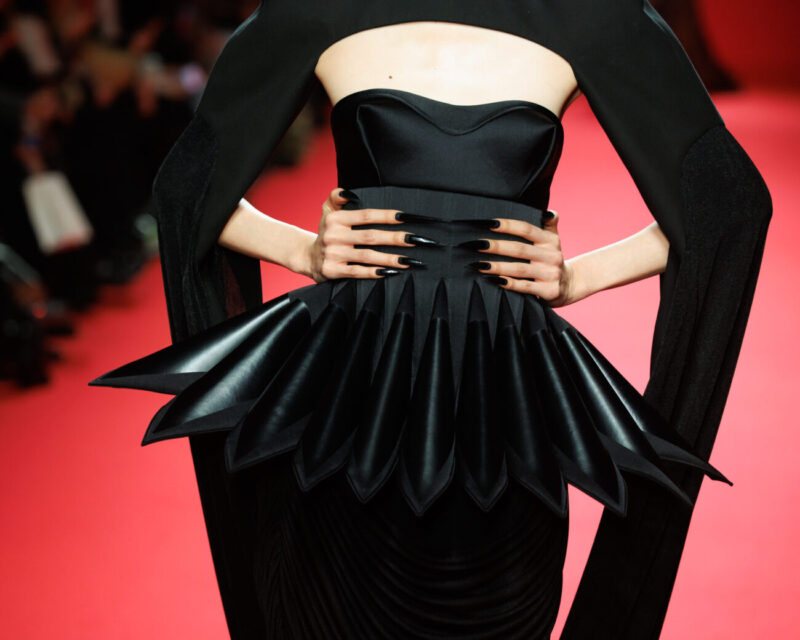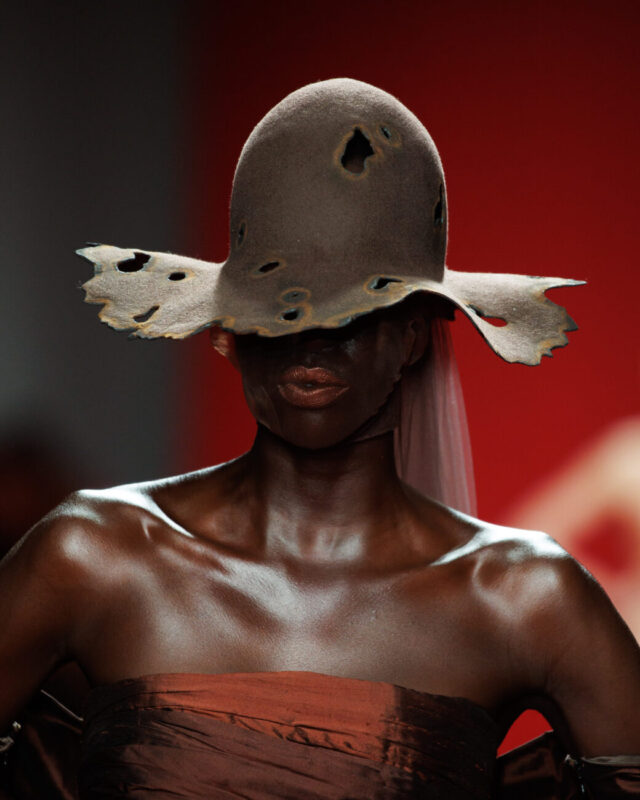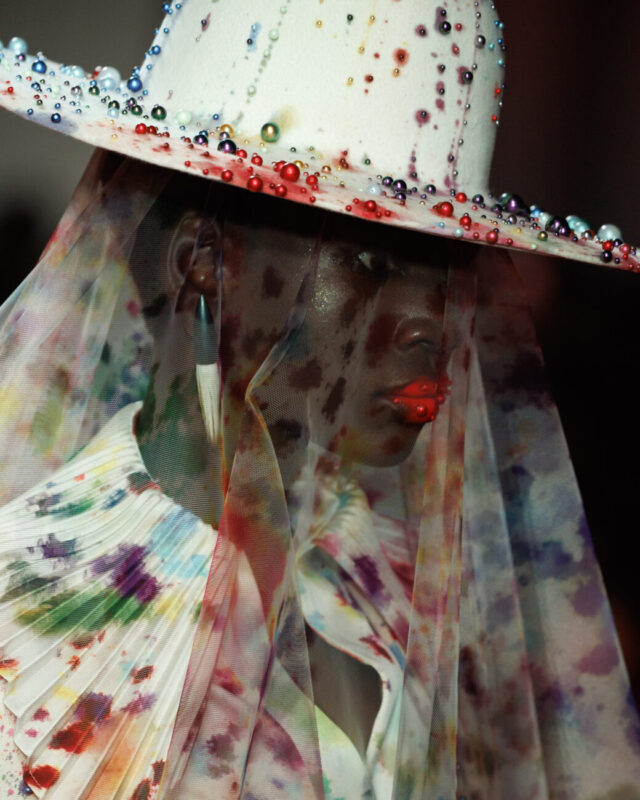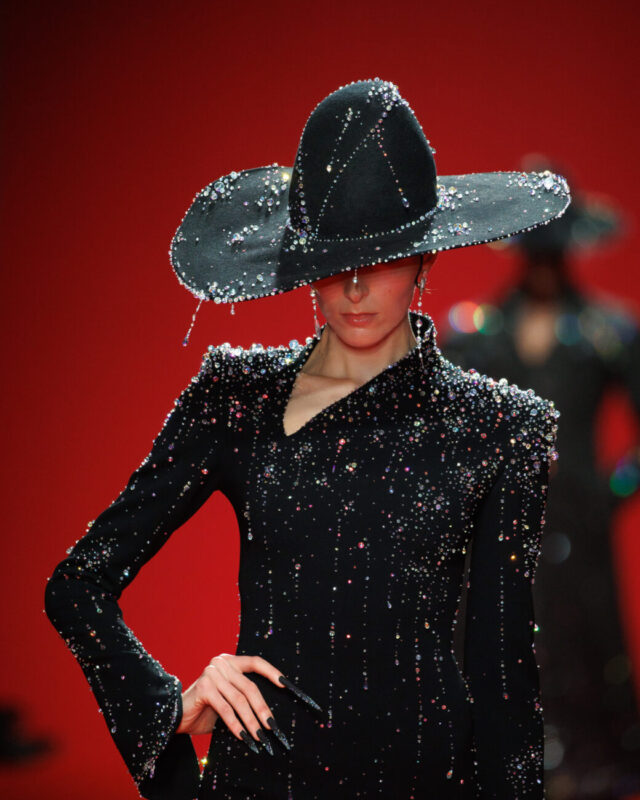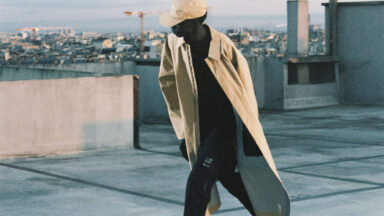Fashion seasons are like weddings that have lasted for 50 years. There must be a secret somewhere for them to work. While prêt-à-porter collections follow unsustainable rhythms, haute couture takes time to reflect. And as in long-term weddings – swings of feelings, even in fashion alternate empty passages to intense, fiery nights of love. In order for the relationship to last a long time, however, in critical moments, equidistance is necessary. Haute couture has this characteristic – despite being considered for the few, elitist, distant, it is free from production needs. It follows its own rhythms and expands over time, allowing the luxury to investigate the contemporary. Moments of crisis are overcome also by dialogue, and in fact haute couture is based on a narrative that is not linear but always finds a way out. In Paris long marriages were celebrated, sometimes unhappy – but full of feelings. Daniel Roseberry for Schiaparelli has imagined a world of Martians who choose fashion as the only form of communication. Kim Jones for Fendi has instead simplified the body – difficult exercise, filling it with poetry. Virginie Viard has finally thrown the heart over the obstacle and for Chanel has unbuttoned the body of women. But couture is also a lot of effort – an emotional struggle, as in the case of Pieter Mulier who through Maison Alaïa has returned to talk about a virtuous body – that is not hidden. Pierpaolo Piccioli for Valentino exaggerated the color. Giorgio Armani instead looked to the East, and remembered the first years of love. But the strongest shock, in the relationship, was given by John Galliano, for Maison Margiela. A story of love, sex, betrayal, tears, passion. In one word, fashion
Words DOMENICO CASORIA
MAISON MARGIELA
Margiela’s nocturnal creatures are the punch in the stomach we deserve. And we have to thank John Galliano, who is back on the scene – he has never really stopped being the most subtle of the magicians (now few) who populate the fashion world. Margiela’s Artisanal collection is incendiary but reflective, it is intimate but has a deep collective spirit, it is raw, reasoned, passionate, sometimes sadistic. In its purest form it is a dialogue of lonely souls who wander and find each other. The show starts with a black and white short film, full of black and full of light – creative. At the heart of Margiela’s new collection, however, there is so much diversity that is intrinsically linked to hedonism – lights, shadows, burning passion. In the ruins under the Seine there is a body that does not look for confirmation, but swings and wiggles thanks to the casting of the models. The body is modified, stripped, exacerbated – revised in shapes, plastics – as in the manner of Helmut Netwon, exaggerated to the limit. Galliano rereads Margiela’s codes, but he does so by combining chaos with theatricality. The show staged in Paris comes straight from the early 90s, when Galliano reacts to a hot decade. Artisanal talks about a contemporaneity that trudges in solitude. A loneliness that the English designer expresses with his creative vein. Which fortunately is back to pulsating blood. And it is also good for the OTB group, chaired by Renzo Rosso who in 2014 called him to the creative direction of Margiela that had entered the portfolio of the founding patron of Diesel.
Galliano once again does what he does best. Fire in the hole. With poetry.
SCHIAPARELLI
It is now evident that the quotationist approach is the fil rouge of the work of Daniel Roseberry for Schiaparelli. And it is clear that the Schiaparelli universe lends itself to this saturated work of input, of all kinds. The presentations of the women’s collections in Paris opened with a pindaric flight in the meanders of the brand. Investigation and exploration, shadows – Roseberry knows how to make fashion and does it very well. The brand’s new collection is inspired by Giovanni Schiaparelli, uncle of Elsa, and famous astronomer who in 1877 discovered the Channels of Mars and who is believed to have been the first to coin the word “Martian” and to advance the hypothesis of different life on the Red Planet. Roseberry then fully fits into the highlights of PFW – space explorations, constellations, other worlds, creating “Schiaparalien” (and goodbye quiet luxury). The dream of the Texan designer is one, and it is evident from the first outing on the catwalk: the creation of a world of his own, in which fashion dictates the time. The collection returns an idea that is imbued with Schiaparelli DNA from head to toe. The clothes therefore do not follow a well-defined design, they are sculptural, extreme, alienating – they are almost scary. On the catwalk a mother comes out with a pearl silk column dress and her cyborg child, an extraterrestrial model with a cocktail dress covered with microchips, calculators and keyboards, a dress in feathers with a lock on the chest in a surrealist key, blazer over that are inspired by the suits for space exploration, tight leather dresses, disproportionate shoulder straps that go over the head and round the body, as in an experiment, combined with boots inspired by the Texas tradition – just to recall the origins of the designer. What goes on stage at Schiaparelli is the most tiring collection created by Roseberry, because it is difficult to work on something that you can only imagine. The themes, however, sometimes open to deeper reflection. The task of haute couture is surely to continue to build a dream that is almost a chimera. While the whole world outside goes up in flames under the deafening blows, Roseberry takes refuge in his microcosm and fantasy on parallel universes. It is good for Schiaparelli, because the brand is reborn from his ashes. “Everything you can imagine is real”.
Simone Rocha from Jean Paul Gaultier is a successful experiment – but basically dangerous.
The perimeter is always that of haute couture. The host brand is JPG, orphaned of its founder who few years ago decided to retire. The guest designer is the Irish Simone Rocha, who took over the reins of the French brand for this high fashion season. The test is interesting because it connects a designer like Gaultier (with everything he brings with him) with a not so newcomer, who shares with Gaultier a certain respect for body shapes. The elements of the collection recall the iconic codes of the maison – the corset, revised by Rocha and left in a soft form, some touches that recall the East, a silhouette unbalanced more towards the spectacularity of the clothes and respectful of the body, at the expense of comfort – combined with the feminine romance forged by lace and pearls, which Rocha declined in a high tailoring.
The interesting idea, however, is that Gaultier’s quotation of the designer draws from the aesthetics of the beginning of the millennium, when the French brand reached a subtle but predominant classicism, without sacrificing the original image of a transformist. Rocha then adds the corsets, but also the guêpière lacing, the printed tattoos, the sailors – but also the famous conical bra. The codes of Gaultier are incorporated crinolines, bustiers and even a quote to the gloves that become fetish. The presentation of haute couture is interesting and the catwalk is almost inclusive (nowadays it is difficult to see models plus size or over 50 years old, in addition to top models). Operation Rocha, however, is yet another reinterpretation of Gaultier, which adds a different point of view, but that stops the minute after the curtain falls on the show. The real doubt is what will stand still Jean Paul Gaultier in this continuous reinterpretation of the glories of the past, without therefore a fixed creative director who tries to put his idea, or how much the (indirectly) cumbersome shadow of the founder is still today, an insurmountable mountain.
“In this world there is nothing certain, except death, taxes and “Designer X x Jean Paul Gaultier”.
I like Kim Jones when he creates men for Dior. I like it less when he creates the ready-to-wear woman for Fendi – and critics like it less, they always give it out and replaced by this or that designer. I did not think the same for Fendi’s haute couture SS 2024 showed in Paris. I did not it for a specific reason. The collection is objectively halfway between two worlds. It preserves and elevates the typical sartorial of haute couture, but renounces (except in the releases dedicated to Lagerfeld) the extreme citation that Kim Jones adopts since he is the creative director of the Roman brand. In addition, the idea of dream that pervades couture, in this case, comes to terms with an idea of body that returns central (and wearable), not prosaic but tending to poetry. It’s true, poetry usually cages in predefined designs, and you run the risk of watering down less positive ideals. Kim Jones does not fall into that trap, and instead introduces that idea of humanism – which also rereads the basics, but deleting all the allegories. The style also follows that idea of body – except for box dresses, that seem to recall rigidity. Everything flows smoothly, thanks to the materials, another cornerstone of the collection – cashmere, vicuña, mohair, crocodile, that are actually in the history of Fendi, and at this point necessary to emphasize the tradition of the house. And then the sequins, in an almost pungent version, but that works. I don’t know how much the homage to Karl Lagerfeld’s futurism is positive for the body, but I remain possibilist. Silvia Venturini Fendi’s perfect work on accessories continues to amaze me, especially Baguette, which also become small precious diamonds in high fashion materials.
The recipe then works (the ingredients are still at the highest level) and Jones keeps bang – in the hope that the body continues to be central – and extremely sharp.
The interesting idea, however, is that Gaultier’s quotation of the designer draws from the aesthetics of the beginning of the millennium, when the French brand reached a subtle but predominant classicism, without sacrificing the original image of a transformist. Rocha then adds the corsets, but also the guêpière lacing, the printed tattoos, the sailors – but also the famous conical bra. The codes of Gaultier are incorporated crinolines, bustiers and even a quote to the gloves that become fetish. The presentation of haute couture is interesting and the catwalk is almost inclusive (nowadays it is difficult to see models plus size or over 50 years old, in addition to top models). Operation Rocha, however, is yet another reinterpretation of Gaultier, which adds a different point of view, but that stops the minute after the curtain falls on the show. The real doubt is what will stand still Jean Paul Gaultier in this continuous reinterpretation of the glories of the past, without therefore a fixed creative director who tries to put his idea, or how much the (indirectly) cumbersome shadow of the founder is still today, an insurmountable mountain.
“In this world there is nothing certain, except death, taxes and “Designer X x Jean Paul Gaultier”.
Haute couture is always a bubble that risks being a showcase for a few elite customers. The real turning point – and few succeed, is to approach couture work as a creative laboratory in which to question central themes. Pieter Mulier, who presented the couture of Maison Alaïa in Paris, succeeded with flying colors. In the salons of the maison, a white canvas and some design elements. An essential space that combines simplicity and purity. Mulier’s work for Alaïa starts from the virtuosity of a single thread of wool that creates light clothes but that fit on the body, or turns into grafts on the sleeves, on the edges of the skirts. The work of the Belgian designer, creative director of the Richemont brand goes deep and analyzes the body. It does not hide it, it does not modify it. It’s a treatise, almost scientific, that opens up a new approach to the body. The silhouette is built on the curvilinear movement, and the idea of haute couture follows the story of Azzedine Alaïa who has always emphasized the body in every corner.
Mulier is a precious stone. And the spiral – like a dress that came out on the catwalk, it’s all upwards.
Haute Couture en Jeu is Giorgio Armani’s new Oriental dream – which after years of mastery never ceases to amaze. The creations that go on stage are light, they attract attention. 92 dresses from the Giorgio Armani Privé collection that tell the story of spring-summer 2024 in fluid fabrics that almost dilate over time. The colors themselves are the journey – they start from soft colors that then become pastel, contaminated with pop nuances. The collection draws stylistically and cuts, from the past century and narrates fashion as an art that is both game and seriousness. At the Palais de Tokyo, the desire to defuse haute couture is on stage. The dresses, which are the protagonists, are inspired by kimonos, long and precious robes, bustier jackets and umbrellas.
Giorgio Armani, almost 90 years old, shows us how fashion is made.
Maria Grazia Chiuri largely eschewed strictly defined themes for an exploration of what the Italian designer called ‘aura’. It speaks to the mood she has conjured during her tenure at the house so far, where despite recalling moments from history – or indeed the house archive – she defined a distinct expression of contemporary femininity. Here, the show was backdropped by a work by artist Isabella Ducrot titled Big Aura, a series of large-scale clothing silhouettes that in their construction recalled the warp and weft of cloth. Indeed, it was fabric – the medium of the couturier – which took centre stage here, with rich moments of moiré, meeting the sheen of iridescent fabrics and the lush textures of velvet. Of moiré – a fabric for which Christian Dior, she noted, had a particular infatuation – she said it ’unfurls over winter like a wave.’ For the silhouettes, Chiuri looked towards La Cigale, a dress that first appeared in Christian Dior’s A/W 1952 collection (there, it was also in moiré). A definitive Dior silhouette – narrowed at the waist and cantilevered at the hip to shape the posture – the strict line was reinterpreted with new ease by the designer, across gowns that wrapped around the body and gently nipped at the waist, or a series of hourglass tailored jackets worn with free-flowing plissé skirts.
A gown in ash-colored tulle was paired with a wide-brimmed felt hat with burn holes, while another looked to be engulfed in flames. Face coverings enhanced the dehumanization of several looks. One of his bridal ensembles was embroidered with crystals to resemble freshly glistening blood-stains. A coat was covered in jagged shards of glass. The collection was something of a retrospective, looking back over 10 years since he created his brand. There were reprisals of now-familiar silhouettes, but with a more confident hand, proof the designer is hitting his stride, of which there was also plenty sitting front row. The opening looks, in charcoal wool, were embroidered with crystals that, from a distance, looked to be realistic raindrops pooling on the fabric, or dripping off the edges of a broad-brimmed felt hat. From umbrella hats and beaked helmets to sculpted hand headpieces that clasped the face, his imaginative headwear merited a special mention. The final look, a dramatic red bustier gown, featured a matching mannequin emerging from the waist at the rear, perched over the model’s shoulders like the weight of the subconscious.
In the Valentino salons overlooking Place Vendôme in Paris, Pierpaolo Piccioli presented Le Salon, the spring/summer 2024 haute couture show. Like all haute couture collections, even the one designed by the Roman designer reflects the values of the contemporary. The central focus of the collection is the color palette, complex – made of contrast colors of each shade that coexists however in perfect harmony. The most interesting point is the study of color. Pierpaolo Piccioli has been studying color since he was creative director of Valentino. This collection, at first glance, may seem like a jumble of elements that do not communicate. Color and the study of volumes are the true essence – and continue to be the description of the humanity – complicated, tangled, crazy. “I can measure the motion of bodies, but not human madness”.
